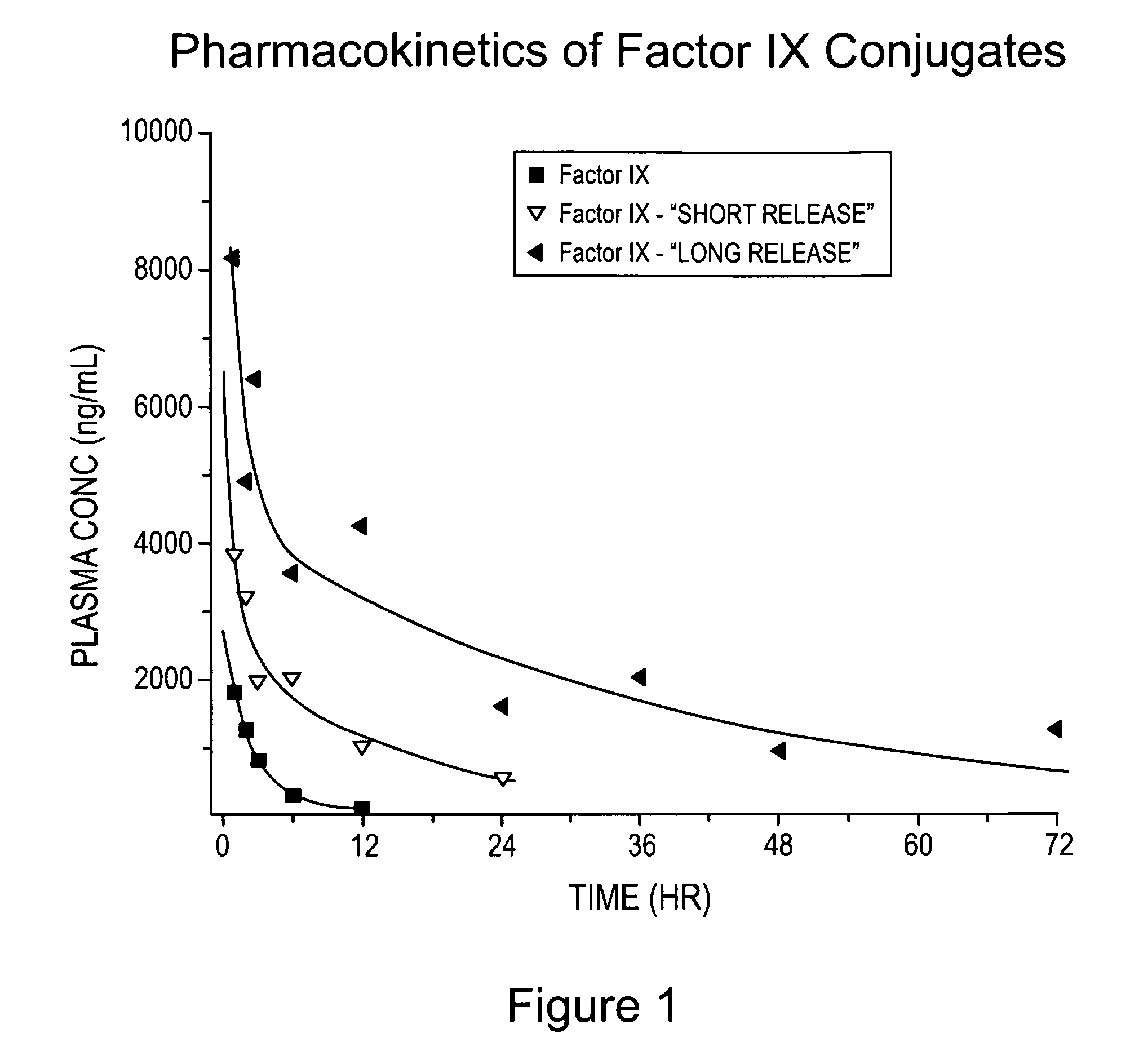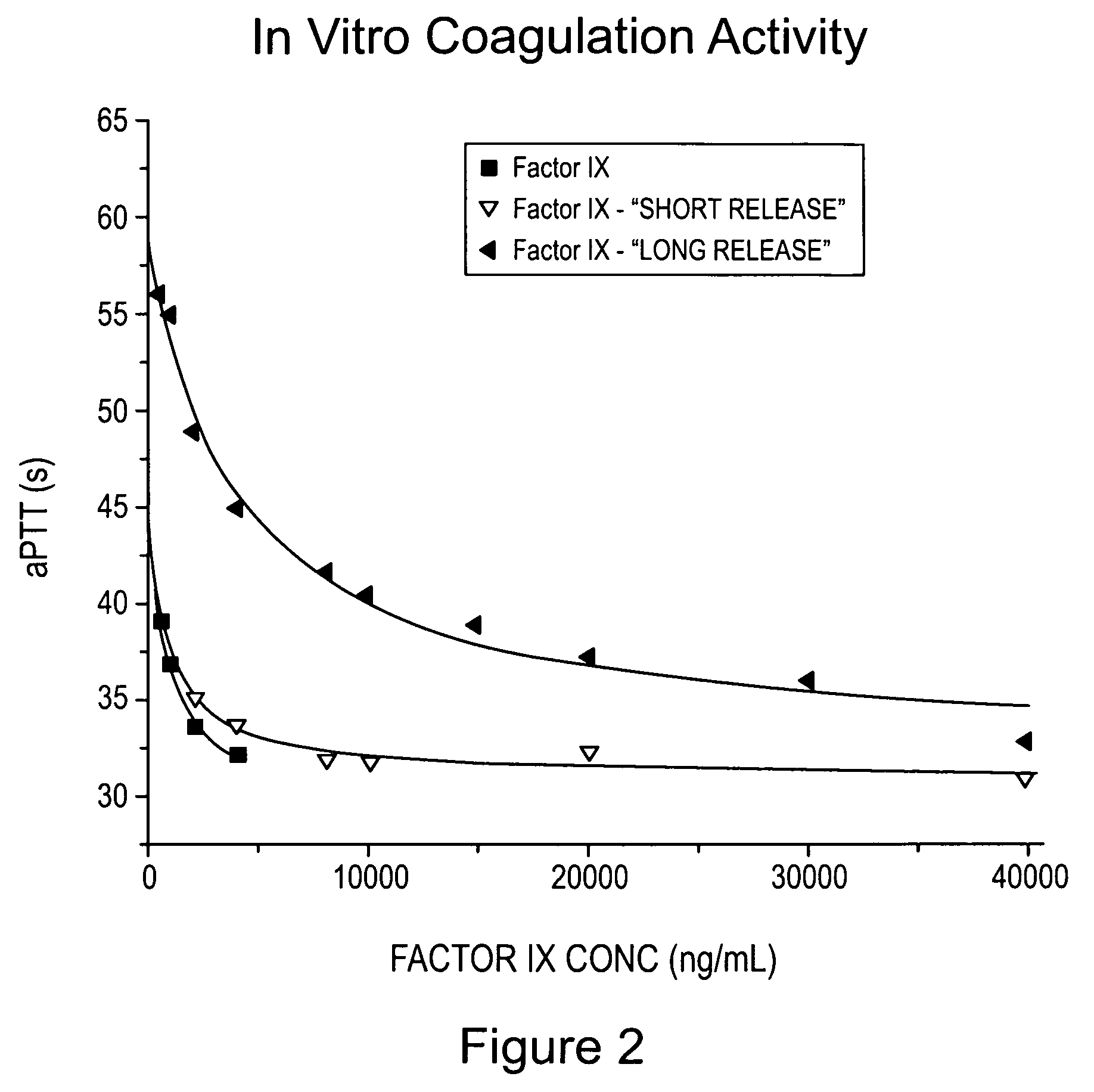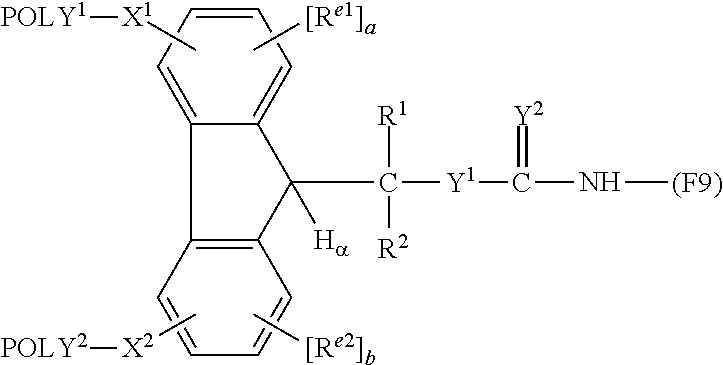Factor IX moiety-polymer conjugates having a releasable linkage
a moiety-polymer and conjugate technology, applied in the field of polymeractive agent conjugates, can solve the problems of inability to exert the intended pharmacodynamic activity of polypeptides, inconvenient and painful, and relative short half-li
- Summary
- Abstract
- Description
- Claims
- Application Information
AI Technical Summary
Benefits of technology
Problems solved by technology
Method used
Image
Examples
example 1
Preparation of Factor IX Conjugate (20,000 Da Total Polymer Weight Average Molecular Weight) (“Short Release”)
[0198][0199](wherein F9 is a residue of Factor IX)
[0200]A vial of Benefix® Factor IX (5.5 mg Factor IX, Wyeth) was removed from 4° C. storage and was allowed to warm to room temperature. The lyophilized powder was resuspended as described in the package insert (10 mL of sterile water per vial). While the Factor IX solution was resolublizing on a rocker plate, polymeric reagent A was removed from −20° C. storage and warmed to room temperature. The Benefix® resuspended liquid was buffer exchanged into 1×PBS+1% Sucrose+0.005% Tween 20 pH 7.3 using a 16 / 10 HiPrep DeSalt column from GE to remove the glycine in the formulation. The protein fractions were collected and pooled into 50 mL conical tubes for the polymer reagent conjugation reaction. A 9.34 excess molar ratio (relative to Factor IX) of polymeric reagent A having a total polymer weight average molecular weight (i.e., the...
example 2
Preparation of Factor IX Conjugate (20,000 Da Total Polymer Weight Average Molecular Weight) (“Long Release”)
[0202][0203](wherein F9 is a residue of Factor IX)
[0204]A vial of Benefix® Factor IX (5.5 mg Factor IX, Wyeth) was removed from 4° C. storage and was allowed to warm to room temperature. The lyophilized powder was resuspended as described in the package insert (10 mL of sterile water per vial). While the Factor IX solution was resolublizing on a rocker plate, the polymeric reagent B was removed from −20° C. storage and warmed to room temperature. The Benefix® resuspended liquid was buffer exchanged into 1×PBS+1% Sucrose+0.005% Tween 20 pH 7.3 using a 16 / 10 HiPrep DeSalt column from GE to remove the glycine in the formulation. The protein fractions were collected and pooled into 50 mL conical tubes for the polymer reagent conjugation reaction. A 9.34 excess molar ratio (relative to Factor IX) of polymeric reagent B having a total polymer weight average molecular weight (i.e., ...
example 3
[0206]The pharmacokinetics of conjugates prepared in accordance with Examples 1 and 2, each have a total polymer weight average molecular weight of 20,000 Da (along with Factor IX as a control) were determined using conventional techniques. Briefly, male SD rats were used (180-220 grams; 6-7 weeks old) and given one 100 μL iv injection. Four animals per group were used and blood plasma collected at various time points (e.g., 0, 1, 2, 3, 6, 12, 24, 36, 48, 72 hours) following injection.
[0207]The results are provided in Table 1 below, wherein V is volume of distribution, CL is total plasma clearance, AUC is area under the plasma concentration-time curve, and T1 / 2 beta is the half-life of the terminal elimination phase. A concentration-time curve was also prepared and is provided as FIG. 1.
[0208]
TABLE 1Conjugate Pharmacokinetics ValuesT1 / 2DoseVCLAUCbeta(ug / kg)Treatment(mL / kg)(mL / hr / kg)(ng / mL*hr / kg)(hr)500Factor IX183.959.38431.52.4500Factor IX - “short release”76.711.84...
PUM
| Property | Measurement | Unit |
|---|---|---|
| weight-average molecular weight | aaaaa | aaaaa |
| polydispersity | aaaaa | aaaaa |
| polydispersity | aaaaa | aaaaa |
Abstract
Description
Claims
Application Information
 Login to View More
Login to View More - R&D
- Intellectual Property
- Life Sciences
- Materials
- Tech Scout
- Unparalleled Data Quality
- Higher Quality Content
- 60% Fewer Hallucinations
Browse by: Latest US Patents, China's latest patents, Technical Efficacy Thesaurus, Application Domain, Technology Topic, Popular Technical Reports.
© 2025 PatSnap. All rights reserved.Legal|Privacy policy|Modern Slavery Act Transparency Statement|Sitemap|About US| Contact US: help@patsnap.com



